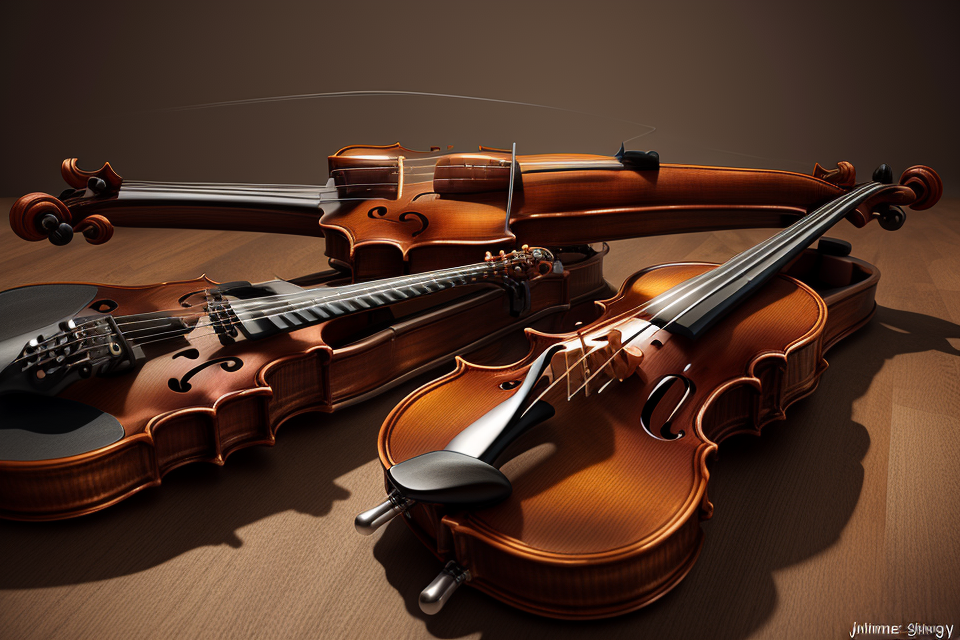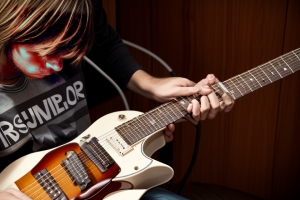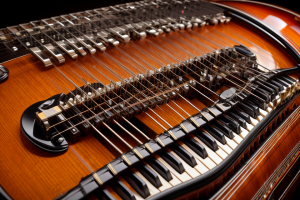
User Guide
When an instrument is out of tune, it means that the pitch produced by the instrument is not in harmony with the desired pitch. This can happen for a variety of reasons, such as changes in temperature or humidity, aging of the instrument, or simply not being properly tuned. Being out of tune can have a significant impact on the sound quality of the instrument and can make it difficult to play in tune with other instruments or singers. Understanding the importance of proper tuning and how to adjust it can help musicians of all levels improve their playing and ensure that their instruments are in top condition. In this article, we will explore the concept of instrument tuning and what it means when an instrument is out of tune.
What is Instrument Tuning?
Definition of Instrument Tuning
Instrument tuning refers to the process of adjusting the pitch of an instrument to produce the desired sound quality. It involves making small adjustments to the strings, keys, or other components of the instrument to ensure that they vibrate at the correct frequency.
There are several different methods of instrument tuning, including:
- Pitch pipes: A small instrument that produces a reference pitch, which can be used to tune other instruments.
- Electronic tuners: A device that uses a microphone to detect the pitch of an instrument and display it on a screen.
- Ear training: The process of developing the ability to hear and recognize pitches accurately, and adjusting an instrument accordingly.
Regardless of the method used, the goal of instrument tuning is to ensure that all of the notes played on the instrument are in tune with each other, and with the intended pitch. This can be achieved through a combination of skill, practice, and attention to detail.
Importance of Instrument Tuning
- Ensuring proper sound quality
- Enhancing musical performance
- Preventing damage to the instrument
- Maintaining proper intonation
- Improving the longevity of the instrument
- Enabling proper communication between instruments during ensemble playing
- Facilitating proper recording and amplification of the instrument
- Enhancing the overall experience of playing the instrument
Types of Instrument Tuning
There are various types of instrument tuning that can be employed to achieve the desired pitch and harmony when playing a musical instrument. Some of the most common types of instrument tuning include:
- Equal Temperament Tuning:
Equal Temperament Tuning is a method of tuning in which each note is tuned to a specific frequency that is in a simple ratio to the next note. This method is widely used in modern music and is designed to produce a consistent and even pitch across all the notes. - Just Intonation Tuning:
Just Intonation Tuning is a method of tuning that is based on the harmonic series. In this method, each note is tuned to a specific frequency that is in a simple ratio to the next note. This method produces a more natural and pleasing sound but can be difficult to achieve consistently. - Pythagorean Tuning:
Pythagorean Tuning is a method of tuning that is based on the Pythagorean theorem. In this method, each note is tuned to a specific frequency that is in a simple ratio to the next note. This method produces a bright and resonant sound but can be challenging to tune accurately. - Meantone Tuning:
Meantone Tuning is a method of tuning that is similar to Equal Temperament Tuning but with slightly different frequencies for each note. This method is designed to produce a more consistent and even pitch across all the notes but can sound somewhat dissonant.
Understanding the different types of instrument tuning is essential for musicians to achieve the desired pitch and harmony when playing their instruments. By selecting the appropriate tuning method, musicians can create a wide range of sounds and tones to suit their musical style and preferences.
Factors Affecting Instrument Tuning
There are several factors that can affect the tuning of an instrument. Some of the most common factors include:
- Temperature and humidity: Changes in temperature and humidity can cause an instrument to become out of tune. This is because the wood in the instrument expands or contracts, causing the strings to stretch or become slack.
- Age: As an instrument ages, the wood can dry out and shrink, causing the instrument to become out of tune.
- Strings: The type of strings used on an instrument can also affect tuning. Different strings have different tensions, and if the wrong type of string is used, it can cause the instrument to become out of tune.
- Maintenance: Regular maintenance, such as tightening or loosening the strings, can affect the tuning of an instrument. If the strings are not properly maintained, it can cause the instrument to become out of tune.
- Playing style: The way an instrument is played can also affect tuning. For example, if an instrument is played aggressively, it can cause the strings to stretch and become slack, causing the instrument to become out of tune.
Understanding these factors can help you to better maintain and tune your instrument, ensuring that it stays in optimal condition and sounds its best.
What Happens When an Instrument Is Out of Tune?
Causes of Instrument Tuning Issues
When an instrument is out of tune, it means that the strings or other components responsible for producing sound are not vibrating at the correct frequency. This can result in a range of issues, including poor sound quality, difficulty in playing, and potential damage to the instrument. There are several common causes of instrument tuning issues, including:
- Temperature and humidity changes: Extreme changes in temperature and humidity can cause the wood and metal components of an instrument to expand or contract, leading to tuning issues.
- Improper tuning: If an instrument is not properly tuned, it can remain out of tune even after adjustments have been made. This can occur if the instrument has not been played for an extended period, or if the tuning pegs or other mechanisms are worn or damaged.
- Poor quality strings: Low-quality strings can be prone to slipping or breaking, which can cause tuning issues. Additionally, they may not hold their tension as well as higher-quality strings, leading to a lack of stability in the instrument’s tuning.
- Structural issues: If an instrument has structural issues, such as a warped neck or a cracked body, it may be difficult or impossible to tune it properly.
- Age: As instruments age, their components can become worn or damaged, leading to tuning issues. Additionally, the wood may dry out over time, causing the instrument to become more difficult to tune.
It is important to address the cause of the tuning issue in order to properly correct it. This may involve adjusting the instrument’s mechanisms, replacing worn or damaged parts, or selecting higher-quality strings. In some cases, a professional repair or restoration may be necessary to address more significant structural issues.
Effects of Instrument Tuning Issues
When an instrument is out of tune, it can have a significant impact on the overall sound quality of the music being played. Here are some of the effects of instrument tuning issues:
- Inconsistent Sound: One of the most noticeable effects of an instrument being out of tune is that the sound produced may not be consistent. This can make it difficult for the musician to play in time with other musicians or to maintain a consistent rhythm.
- Muffled Sound: When an instrument is not properly tuned, the sound produced may be muffled or dull. This can make it difficult for the musician to project their sound and for the audience to hear the music clearly.
- Inaccurate Notes: Another effect of an instrument being out of tune is that the notes produced may not be accurate. This can make it difficult for the musician to play the correct notes and can lead to mistakes in the music.
- Poor Timbre: The timbre of an instrument is the unique tone or quality of its sound. When an instrument is out of tune, the timbre of the sound produced may be poor or distorted. This can affect the overall sound quality of the music being played.
- Strain on the Musician: When an instrument is not properly tuned, it can be more difficult for the musician to play and may cause physical strain. This can lead to fatigue and discomfort during long performances or rehearsals.
Overall, instrument tuning issues can have a significant impact on the sound quality of the music being played and can make it difficult for the musician to perform at their best. It is important for musicians to regularly tune their instruments to ensure that they are producing the best possible sound.
Diagnosing Instrument Tuning Issues
Diagnosing instrument tuning issues can be a challenging task, especially if you are not familiar with the intricacies of musical instruments. However, with a little knowledge and practice, you can quickly identify when your instrument is out of tune. Here are some steps to help you diagnose instrument tuning issues:
- Check the instrument’s tuning pegs: The first step in diagnosing instrument tuning issues is to check the tuning pegs. Make sure they are tight and not loose. If the pegs are loose, the strings may not hold their tuning properly. Tighten the pegs as needed and check the tuning again.
- Use a tuner: A tuner is an essential tool for diagnosing instrument tuning issues. You can use a digital tuner or a tuning fork to help you determine if your instrument is in tune. Place the tuner or tuning fork next to the instrument and adjust the strings until the tuner indicates that the strings are in tune.
- Check the string height: The height of the strings above the fretboard can also affect the instrument’s tuning. If the strings are too high, they may buzz against the fretboard, causing the instrument to sound out of tune. Adjust the string height by tweaking the truss rod or adjusting the bridge.
- Listen for inconsistencies: Finally, listen to the instrument carefully and identify any inconsistencies in the sound. If you hear a noticeable difference in pitch or tone, the instrument may be out of tune. Use a tuner to help you identify the problem area and adjust the strings accordingly.
By following these steps, you can diagnose instrument tuning issues and ensure that your instrument is in top condition for playing.
Correcting Instrument Tuning Issues
When an instrument is out of tune, it means that the pitch of the notes being played is not in harmony with the rest of the instrument or with other instruments being played in the same key. This can result in a discordant or unpleasant sound that can be difficult to listen to.
Fortunately, correcting instrument tuning issues is usually a simple process. Here are some steps you can take to get your instrument back in tune:
- Check the instrument’s tuning pegs or machine heads. If they are loose or tight, adjust them to bring the strings to the correct pitch.
- Use a tuner to help you tune the instrument. There are many different types of tuners available, from basic tuning forks to digital tuners that can be used with a smartphone or tablet.
- Start by tuning the lowest string first, and work your way up to the highest string. Use the tuner to check the pitch of each string and adjust the tuning pegs or machine heads as needed.
- Check the intonation of the instrument. Intonation refers to the accuracy of the pitch of each note along the length of the strings. If the intonation is off, it can cause notes to sound out of tune even when the overall tuning is correct.
- If you are still having trouble getting your instrument to stay in tune, it may be time to have it checked by a professional. A luthier or instrument repair technician can help diagnose any issues with the instrument and make any necessary adjustments or repairs.
By following these steps, you can get your instrument back in tune and enjoy playing music again.
Common Instrument Tuning Problems
Piano Tuning Issues
When it comes to piano tuning issues, there are several problems that can arise. One common problem is when the piano is not properly tuned, it can lead to poor sound quality. This can be caused by a variety of factors, such as changes in temperature and humidity, which can affect the tension of the strings and the pitch of the notes. Additionally, a piano that is not regularly tuned can suffer from wear and tear on its mechanisms, leading to a loss of precision and a decline in overall performance.
Another issue that can arise with piano tuning is uneven tuning, where some strings are tuned to the correct pitch, while others are not. This can create a discordant sound when playing certain pieces of music, and can make it difficult for the player to achieve the desired sound.
A third issue that can occur with piano tuning is that the piano may have gone out of tune due to normal wear and tear, which can happen over time as the wooden parts of the piano expand and contract with changes in temperature and humidity. This can cause the pitch of the notes to change, and can require the piano to be retuned to restore proper sound quality.
In order to address these issues, it is important to have a qualified piano tuner regularly check and adjust the tuning of the instrument. They will be able to identify any problems and make the necessary adjustments to ensure that the piano is in optimal condition and producing the best possible sound.
Guitar Tuning Issues
When it comes to guitar tuning issues, there are several problems that players may encounter. These can include:
- Intonation Problems: This occurs when the guitar’s neck is not properly aligned, causing the strings to be out of tune when played in certain positions along the neck.
- String Height Problems: This occurs when the strings are too high off the fretboard, causing buzzing or other sounds when played.
- Tuning Stability: This refers to the guitar’s ability to hold its tuning over time. Some guitars may have poor tuning stability, causing the strings to go out of tune more frequently.
- Bridge Issues: The bridge of a guitar can affect the instrument’s tuning, as it can change the tension of the strings. If the bridge is misaligned or damaged, it can cause tuning problems.
- Climate Changes: Extreme changes in temperature and humidity can affect the tuning of a guitar, as the wood expands or contracts. This is especially true for acoustic guitars, which are more susceptible to changes in the environment.
Understanding these common guitar tuning issues can help players identify and address problems with their instrument, ensuring that it is always in top condition for playing.
Violin Tuning Issues
One of the most common instrument tuning problems is violin tuning issues. Violins are delicate instruments that require precise tuning to produce the best sound quality. Here are some of the most common violin tuning issues and how to address them:
Stretched or Loose Strings
Stretched or loose strings are a common issue in violin tuning. This can happen when the strings are overstretched or under-tightened. If the strings are stretched, they will produce a sharp pitch, while if they are loose, they will produce a flat pitch. To address this issue, you need to adjust the tension of the strings by using the pegs or the tailpiece. If the strings are too sharp, loosen the peg or the tailpiece slightly. If the strings are too flat, tighten the peg or the tailpiece slightly.
Poor Intonation
Poor intonation is another common violin tuning issue. This occurs when the strings are not in tune with each other, resulting in a discordant sound. To address this issue, you need to adjust the tuning pegs or the bridge. You can also use a tuner to help you fine-tune the strings.
Cracked or Rusted Bridge
A cracked or rusted bridge can also cause violin tuning issues. This can happen due to dry weather conditions or poor maintenance. If the bridge is cracked or rusted, it can affect the pitch and tone of the violin. To address this issue, you need to have the bridge repaired or replaced by a professional luthier.
Worn Out or Broken Pegs
Worn out or broken pegs can also cause violin tuning issues. This can happen due to frequent use or wear and tear. If the pegs are worn out or broken, they may slip or refuse to hold the strings in place. To address this issue, you need to replace the pegs with new ones or have them repaired by a professional luthier.
By addressing these common violin tuning issues, you can ensure that your violin produces the best sound quality possible. Regular maintenance and tuning are essential to prevent these issues from arising in the first place.
Other Instrument Tuning Issues
When it comes to instrument tuning, there are a variety of issues that can arise beyond just being out of tune. Here are some of the other common instrument tuning problems that musicians may encounter:
Stretched Pitches
One issue that can occur is when strings or keys are stretched, causing the pitch to be raised. This can happen when strings are old or when keys are not properly adjusted. When a string is stretched, it becomes longer, which raises the pitch. This can cause problems when trying to achieve the correct tuning for a particular piece of music.
Flat Notes
Another issue that can arise is when notes are flat, or lower in pitch than they should be. This can occur when strings are worn or when the tuning pegs are not properly tightened. When a string is worn, it becomes thinner, which lowers the pitch. This can cause problems when trying to achieve the correct tuning for a particular piece of music.
Sharp Notes
On the other hand, sharp notes, or notes that are higher in pitch than they should be, can also be a problem. This can occur when strings are too tight or when the tuning pegs are not properly loosened. When a string is too tight, it becomes thicker, which raises the pitch. This can cause problems when trying to achieve the correct tuning for a particular piece of music.
Uneven Tuning
Finally, uneven tuning can occur when some strings are in tune, but others are not. This can happen when some strings are stretched or worn, while others are not. This can cause problems when trying to achieve a balanced sound across all strings.
It’s important for musicians to be aware of these common instrument tuning problems and to take steps to address them in order to achieve the best possible sound from their instruments.
How to Prevent Instrument Tuning Issues
Proper Storage and Handling of Instruments
When it comes to preventing instrument tuning issues, proper storage and handling of instruments are crucial. Here are some tips to ensure that your instruments stay in tune and remain in good condition:
- Keep instruments in their cases when not in use. This will help protect them from accidental damage and keep them in optimal condition.
- Use a humidifier in the room where the instruments are stored to maintain the appropriate humidity level. Extreme changes in humidity can cause the wood to expand or contract, affecting the instrument’s tuning.
- Avoid exposing instruments to extreme temperatures. High temperatures and direct sunlight can cause the wood to expand, while low temperatures can cause it to contract. This can lead to changes in the instrument’s tuning.
- Clean and maintain instruments regularly. Dirt, dust, and debris can accumulate on the instrument’s surface, affecting its tuning and overall condition. Use a soft, dry cloth to wipe down the instrument and remove any debris.
- Handle instruments with care. Instruments are delicate and can be easily damaged if mishandled. Avoid dropping or bumping them, and always hold them by the handles or neck when moving them.
By following these simple tips, you can help prevent instrument tuning issues and ensure that your instruments stay in top condition.
Regular Maintenance and Servicing of Instruments
Regular maintenance and servicing of instruments are crucial in preventing tuning issues. This involves checking and adjusting the instrument’s mechanisms, cleaning, and oiling the moving parts, and replacing any worn-out or damaged components. Here are some of the essential aspects of regular maintenance and servicing of instruments:
- Checking and adjusting the mechanisms: Regularly checking and adjusting the mechanisms of the instrument can help prevent tuning issues. This involves inspecting the tuning pegs, the bridge, and the nut, and making any necessary adjustments to ensure that they are functioning correctly.
- Cleaning and oiling the moving parts: Instruments have many moving parts, and over time, they can become dirty and grimy. Cleaning the instrument regularly and oiling the moving parts can help prevent tuning issues by ensuring that the mechanisms are functioning smoothly.
- Replacing worn-out or damaged components: Worn-out or damaged components can cause tuning issues. Regular maintenance and servicing of instruments involve inspecting the instrument for any worn-out or damaged components and replacing them as necessary.
- Adjusting the strings: The strings of the instrument can also cause tuning issues if they are not properly adjusted. Regular maintenance and servicing of instruments involve checking the strings and adjusting them as necessary to ensure that they are in good condition and properly tensioned.
Overall, regular maintenance and servicing of instruments are essential in preventing tuning issues. Instrument owners should work with a qualified technician or luthier to ensure that their instruments are well-maintained and in good condition.
Adjusting Instruments for Temperature and Humidity Changes
Maintaining the optimal temperature and humidity levels is crucial in preventing instrument tuning issues. Instruments are sensitive to changes in temperature and humidity, which can cause them to expand or contract, resulting in misalignment of the strings and the fretboard. In this section, we will discuss the importance of adjusting instruments for temperature and humidity changes.
Temperature and humidity can significantly affect the tuning of stringed instruments such as guitars, violins, and cellos. As the temperature changes, the strings can become loose or tight, causing the instrument to go out of tune. For example, when the temperature rises, the strings can become loose, causing the instrument to drop in pitch. On the other hand, when the temperature drops, the strings can become tighter, causing the instrument to raise in pitch.
Humidity also plays a significant role in instrument tuning. When the humidity is high, the wood used to make the instrument can expand, causing the strings to become loose and the instrument to go out of tune. Conversely, when the humidity is low, the wood can contract, causing the strings to become tighter and the instrument to go out of tune.
To prevent instrument tuning issues caused by temperature and humidity changes, it is important to take steps to regulate the environment in which the instrument is stored or played. One way to do this is to use a humidifier or dehumidifier to maintain the appropriate humidity level. It is also important to keep the instrument in a room with a stable temperature, away from direct sunlight or heat sources.
In addition to using a humidifier or dehumidifier, it is important to regularly check the tuning of the instrument and make adjustments as needed. This is especially important when traveling to different climates or environments, as the change in temperature and humidity can cause the instrument to go out of tune.
By taking these steps to regulate the environment in which the instrument is stored or played, musicians can prevent instrument tuning issues caused by temperature and humidity changes. This will ensure that the instrument stays in tune and can be played at its best, providing musicians with the peace of mind they need to focus on their performance.
Choosing the Right Strings and Accessories for Your Instrument
When it comes to instrument tuning, choosing the right strings and accessories is crucial in preventing tuning issues. Here are some tips to consider:
Factors to Consider When Choosing Strings
When selecting strings for your instrument, there are several factors to consider. First, you need to choose the right gauge or thickness of the string. A thicker string will produce a lower pitch, while a thinner string will produce a higher pitch. It’s important to choose strings that are compatible with your instrument’s tuning system and playing style.
You should also consider the material of the string. Steel strings are popular for their durability and affordability, but they can be loud and produce a harsh tone. On the other hand, nylon strings are more flexible and produce a smoother tone, but they can be more expensive and require regular replacement.
Choosing the Right Accessories
In addition to choosing the right strings, selecting the right accessories can also help prevent tuning issues. For example, if you play a stringed instrument like a guitar or violin, you may need to invest in a tuner to ensure that your strings are properly tuned. There are various types of tuners available, including clip-on tuners, pedal tuners, and software tuners.
You may also need to purchase extra strings, a guitar strap, or a carrying case to protect your instrument when you’re not using it. Additionally, it’s important to regularly clean and maintain your instrument to prevent damage and maintain optimal performance.
In summary, choosing the right strings and accessories for your instrument is essential in preventing tuning issues. By considering factors such as gauge, material, and compatibility, you can ensure that your instrument stays in tune and performs at its best.
Recap of Key Points
To prevent instrument tuning issues, it is essential to understand the fundamentals of instrument tuning. The following are some key points to consider:
- Proper Storage: Store your instrument in a dry and cool place to prevent damage to the wood or metal components. Avoid exposing your instrument to extreme temperatures or humidity.
- Regular Maintenance: Regular maintenance is crucial to keep your instrument in good condition. Clean the instrument after each use, and make sure all the parts are working correctly. If you notice any issues, contact a professional for repairs.
- Proper Tuning: Proper tuning is essential to ensure that your instrument sounds its best. Regularly tune your instrument, and use a tuner to help you maintain the correct pitch.
- Checking for Damage: Inspect your instrument regularly for any signs of damage, such as cracks or warping. If you notice any damage, contact a professional for repairs immediately.
- Humidity Control: Humidity can affect the tuning of your instrument. Use a humidifier or dehumidifier to maintain the correct humidity level in your instrument’s environment.
By following these key points, you can prevent instrument tuning issues and ensure that your instrument stays in good condition for years to come.
Final Thoughts on Instrument Tuning and Maintenance
Maintaining your instrument is crucial to ensuring it stays in tune and functions properly. Here are some final thoughts on instrument tuning and maintenance:
- Regular maintenance: Regular maintenance is key to preventing tuning issues. This includes cleaning and inspecting your instrument for any signs of wear or damage.
- Humidity control: Extreme changes in humidity can cause your instrument to go out of tune. It’s important to control the humidity level in the room where your instrument is stored.
- Proper storage: Proper storage is also important to prevent tuning issues. Your instrument should be stored in a dry, cool place, away from direct sunlight and extreme temperatures.
- Professional servicing: It’s recommended to have your instrument serviced by a professional every six months to a year. This will ensure that any issues are caught early and prevented from becoming more serious.
By following these tips, you can help prevent instrument tuning issues and keep your instrument in top condition.
FAQs
1. What does it mean when an instrument is out of tune?
When an instrument is out of tune, it means that the pitch of the notes being played is not in harmony with the pitch of the notes that are supposed to be played. This can result in a discordant or unpleasant sound. Out of tune instruments can make it difficult to play in harmony with other instruments or singers, and can also make it harder to achieve the desired sound or tone.
2. What causes an instrument to be out of tune?
There are several factors that can cause an instrument to be out of tune, including changes in temperature and humidity, wear and tear on the instrument, and even the way the instrument is being played. Some instruments, such as the violin or cello, require regular tuning to maintain the correct pitch, while others, such as the piano or trumpet, are less affected by changes in temperature and humidity.
3. How can I tell if my instrument is out of tune?
The easiest way to tell if your instrument is out of tune is to listen to the sound it produces. If the pitch of the notes sounds off or unpleasant, it may be out of tune. You can also use a tuner or a pitch pipe to check the pitch of your instrument and compare it to the desired pitch. Some instruments, such as the guitar or ukulele, have built-in tuners that make it easy to check and adjust the pitch.
4. How can I fix an out of tune instrument?
The best way to fix an out of tune instrument is to adjust the tuning. This can usually be done by adjusting the tuning pegs or keys on the instrument. It’s important to use a tuner or pitch pipe to ensure that the instrument is being tuned to the correct pitch. If the instrument is severely out of tune, it may need to be adjusted by a professional instrument repair technician.
5. How often should I tune my instrument?
The frequency with which you should tune your instrument depends on several factors, including the type of instrument, the environment it is being played in, and how often it is being played. Some instruments, such as the violin or cello, require daily tuning to maintain the correct pitch, while others, such as the piano or trumpet, may only need to be tuned occasionally. It’s a good idea to consult with a music teacher or professional instrument repair technician to determine the best tuning schedule for your instrument.






